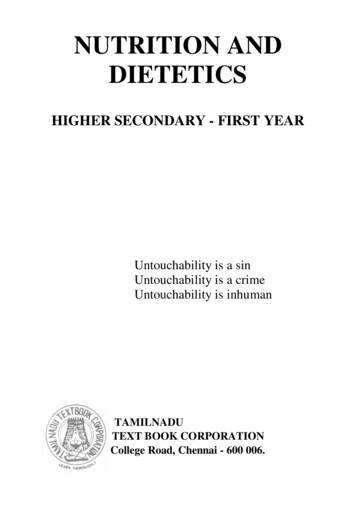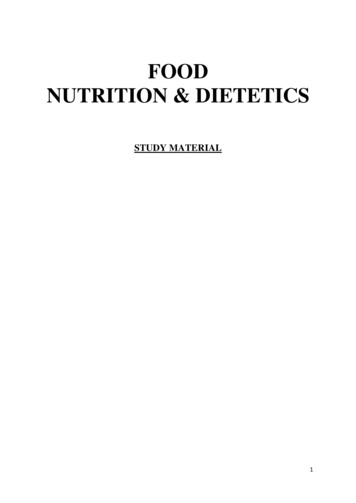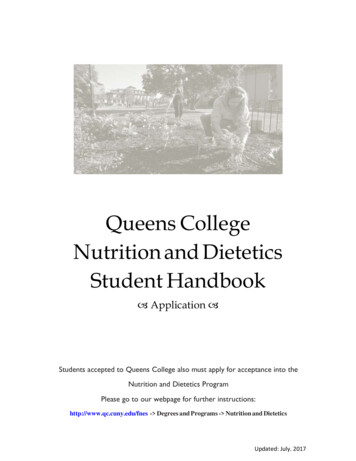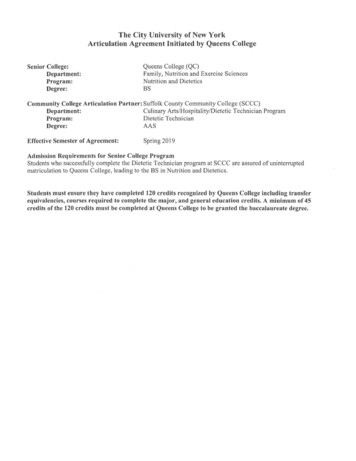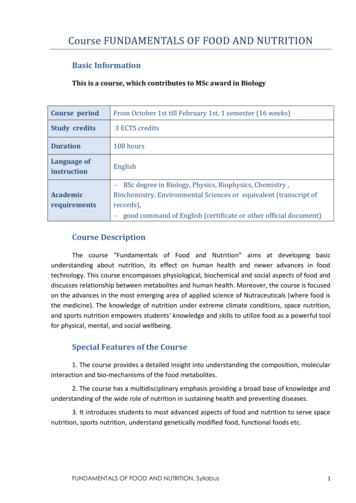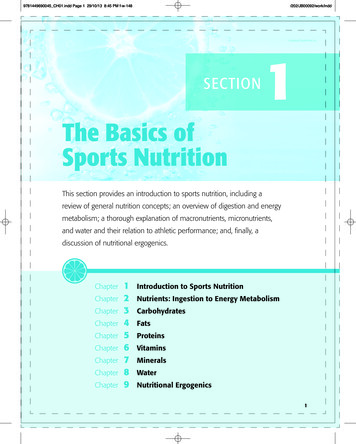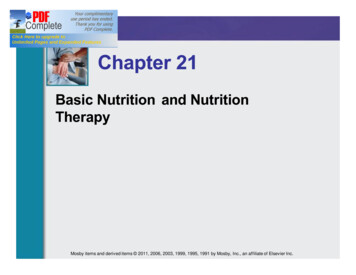
Transcription
REVISED SYLLABI(Effective from the academic year 2009-2010 onwards)B. Sc. NUTRITION AND DIETETICSDepartment of Nutrition and DieteticsAchariya College of Arts and Science, Villianur.(Affiliated to Pondicherry University)
SEMESTER – INAD101: FOOD SCIENCE -1UNIT I: INTRODUCTION TO FOODS8 hoursDefinition, functions, food groups, classification of foods. Study of different cooking methods, merits anddemerits, Solar cooking, Microwave cooking. Cereals - Cereals and millets- breakfast cereals, cerealproducts, fast foods- structure, processing, use in variety of preparation, selection, variety, storage,nutritional aspects and cost.UNIT II: PULSES8 hoursPulses and legumes- Production (in brief), Selection and variety, storage, processing, use in variety ofpreparation, nutritional aspects and cost. Highlighting soya beans, lathyrism- removal of toxins.UNIT III: MILK AND MILK PRODUCTS8 hoursComposition, classification, quality, processing, coagulation of milk, digestion of milk, storage, uses andcost. Nutritional aspects of milk, curd, butter, paneer, khoa, cheese, ice cream, kulfi and various kinds ofprocessed milk.UNIT IV: EGG, FISH, POULTRY AND MEAT8 hoursSelection, quality, purchase, storage, uses and nutritional aspects. Spoilage of egg, fish, poultry and meat.UNIT V: VEGETABLES AND FRUITS8 hoursVariety, selection, purchase, storage, availability, cost, use and nutritional aspects of raw and processedvegetables and fruits. Effects of cooking on colour, texture, flavour, appearance and nutritive value.1
TEXT BOOKS1. Swaminathan (1995): “Food & Nutrition”, The Bangalore Printing & publishing co ltd., Vol I,Second Edition, Bangalore.2. Srilakshmi (1997): “Food Science”, New Age International (P) Ltd, Publishers, Pune.REFERENCE BOOKS1. Mudambi .R. Sumathi & Rajagpal M.V (1983), “Foods & Nutrition”, Willey Eastern Ltd,Second Edition, New Delhi.2. Thangam.E.Philip(1965): Modern Cookery, Orient Longman, II edition. Vol II, Bombay.2
NAD105: PRACTICAL – IFOOD SCIENCE -11. Familarisation with different stoves, ovens and simple kitchen equipment.2. Methods of measuring and weighing dry ingredients and liquids.3. Cereal cookerya. Methods of combining flour with liquid eg. Powdered cereal coarse(eg. Phirnee, broken wheatuppuma) and fine (eg. Ragi porridge, wheat halwa).b. Cereal Grains – different methods of cooking rice – straining, absorption – cooking overslow heat, pressure cooking, addition of fat, microwave and rice cooker.c. Rice preparations – lime rice, tamarind rice, coconut rice, curd rice, egg fried rice, peasfried rice, iddli and dosai.d. Wheat and ragi preparations – Kesari, poori, paratha, bhathura, naan, ragiputtu, ragi leaf cake, ragi adai.4. Pulse Cookerya. Different methods of cooking pulses – hard water, soft water, soaking, additionof soda bicarbonate, addition of raw papaya, pressure cooking eg. Any whole gram andany dhal.b. Pulse Preparations – brinjal sambar, sprouted green gram patchadi, cow peas sundal,adai, tomato dhal maseel, ven pongal, ompodi, sugian, freen gram payasam, masalavadai and chole.5. Vegetable Cookerya. Different methods of cooking vegetables – effect of shredding, dicing, acid and alkali, pressurecooking, steaming with and without lid. Eg. Potato, beetroot, carrot and greens.b. Vegetable preparations – potato methi curry, mashed potatoes, aloo tikke, vegetable kurma, avail ,keerai maseel, cabbage pugath, carrot cucumber, ridge gourd and green gram dhal kootu, tomatochutney and carrot halwa.6. FruitsDifferent ways of serving oranges, stuffed dates, banana fritters, fruit salad, stewed apricots, bananawith custard, fruit jelly,grape jam, fruit punch, baked apple and pine apple upside down cake.3
NAD102: HUMAN NUTRITIONUNIT I: INTRODUCTION TO NUTRITION7 hoursConcept and definition of terms Nutrition, Malnutrition and Health. Brief History of Nutritional Science,Scope of Nutrition. Minimal Nutritional Requirements and RDA- Formulation of RDA and DietaryGuidelines- Reference Man and Reference women.UNIT II: ENERGY AND CARBOHYDRATES9 hoursEnergy Balance, Assessment of Energy Requirements, Deficiency and Excess.Carbohydrates- Definition, Classification and functions. Digestion and Absorption, Blood glucose andeffect of different carbohydrates on blood glucose. Dietary Fibre - Nutritional significanceUNIT III: PROTIENS8 hoursDefinition, classification and functions. Assessment of protein quality (BV, PER, NPU), Digestion andAbsorption, factors affecting protein bio-availability including anti-nutritional factors. Requirements,deficiency.UNIT IV: LIPIDS8 hoursDefinition, classification and functions of lipids. Digestion and absorption, Intestinal re-synthesis oftriglycerides. Types of fatty acids, role and nutritional significance (SFA,MUFA,PUFA, omega-3).UNIT V: MINERALS, TRACE ELEMENTS AND VITAMINS8 hoursMinerals - Physiological role, bio-availability and requirements, sources, Deficiency and Excess(Calcium,Phosphorus, Magnesium, Iron, Fluoride, Zinc, Iodine)Vitamins-Physiological role, Bio-availability and requirements, sources, deficiency and excess(Fat solubleand water soluble)4
TEXT BOOKS1. Shubhangini A. Joshi,(1992)’ “Nutrition and Dietetics”Tata Mc Grow- Hill publishing Company Ltd,New Delhi.2. Srilakshmi. B – “Nutrition Science”, V Edn, New Age International (P) Ltd, Publishers, ChennaiREFERENCE BOOKS1. Passmone R.and Eastwood M.A,(1986), “Human Nutrition and Dietetics”,English language bookSociety/Churchill Livingstone,Eigth edition, Hong Kong.2. Neiman N. Catherine, (1990), “Nutrition”,Wm.C. Brown Publishers. USA.5
NAD102: HUMAN NUTRITION PRACTICALS1. Estimation of calorific value of food.2. Estimation of moisture content.3. Estimation of ash content.4. Preparation of buffers (acidic, neutral and alkaline) and determination of pH.5. Qualitative identification of carbohydrates – glucose, fructose, galactose, sucrose, maltose, lactose.6. Preparation of Osazones and their identification.7. Qualitative identification of amino acids – histidine, tyrosine, tryptophan, cysteine, arginine.8. Qualitative identification of lipids – solubility, saponification, acrolein test, Salkowski test,Lieberman-Burchard test.9. Qualitative tests for minerals.10. Quantitative estimation of glucose.6
151: HUMAN PHYSIOLOGY - 1UNIT – I: CELL AND TISSUES8 hoursCell – Structure and functions. Physiological properties of protoplasm. Levels of cellular organization.Organelles, tissues, organs and systems. Cell membrane transport. Tissues - Structure and functions ofepithelial, connective, muscular and nervous tissue. Water and electrolyte balance - Distribution of waterand electrolytes, requirements and sources, regulation of water balance, electrolyte balance, deficiencyand excess.UNIT – II: DIGESTIVE SYSTEM7 hoursAccessory organs of digestion – Structure and functions – Teeth, Tongue, Salivary glands; Saliva –Composition and functions. Organs of Digestion – Oesophagus, Stomach, Small intestine and Largeintestine – Structure and functions, Movements of the digestive system. Associated organs of digestion –Liver, Gall bladder, Pancreas (Digestive function) and Spleen. Disorders and Diseases – anorexia,Achlorhydria, Peptic ulcer, gastric ulcer and duodenal ulcer, gastritis, typhoid, jaundice.UNIT- III: CIRCULATORY SYSTEM9 hoursBlood – Formation, composition and functions, blood coagulation, blood groups and Rhesus factor, bloodtransfusion. Disorders – Anemia, Leukemia, hemophilia. Blood vessels – Types of Blood vessels.Disorders – Varicose veins, arteriosclerosis. Blood Pressure – Factors affecting blood pressure,hypertension, Pulse, Tachycardia and Bradycardia. Heart - Structure and functions, cardiac cycle,conduction system of the heart, ECG and its significance. Disorders – Angina pectoris, myocardialinfarction. Lymphatic system – Lymph glands and its functions; Lymph - Composition and functions.UNIT–IV: EXCRETORY SYSTEM8 hoursOrgans of Excretion – Structure and functions of kidney, ureter, urinary bladder, urethra. Mechanism ofurine formation, composition of urine, Micturition. Role of kidney in maintaining pH of blood. Acid-basebalance. Disorders and Diseases – nocturnal enuresis, polyurea, diuresis, uremia, hematuria, nephritis.UNIT-V: RESPIRATORY SYSTEM8 hoursUpper respiratory passages – nasal cavities, pharynx, larynx and trachea. Lungs – Structure and functions,Lung capacity, Respiratory Quotient. Exchange and Transportation of respiratory gases. Role ofhaemoglobin and buffer systems. Disturbances in respiration – Apnea, Dyspnea, Hypoxia. Diseases –Bronchitis, Tuberculosis, Pneumonia, Asthma.7
TEXTBOOKS1. Meyer B J, Meij H S and Meyer A C., Human Physiology, AITBS Publishers and Distributors.2. Wilson, K.J.W and Waugh, A. (1996): Ross and Wilson, Anatomy and Physiology in Health andIllness, 8th Edition, Churchill Livingstone.REFERENCES1. Ranganathan, T.S. (2004): A Textbook of Human Anatomy, Chand & Co. N. Delhi.2. Jain, A.K., Textbook of Physiology, Vol. I and II, Avichal Publishing Co., New Delhi.3. Chatterjee C.C. (1987): Human Physiology, Vol. I & II, Medical Allied Agency, Calcutta.4. Guyton, A.G. and Hall, J.B. (1996): Text Book of Medical Physiology, (9th Edition, W.B. SandersCompany, Prism Books (Pvt.) Ltd., Bangalore.8
153: ALLIED PRACTICAL – IHUMAN PHYSIOLOGY – 11. Microscopic study of different tissues - Epithelial, connective, muscular & nervous tissues2. Microscopic study of digestive organs - Pancreas, stomach, small intestine, liver3. Microscopic study of respiratory organs - Lung, trachea4. Microscopic study of excretory system - Kidney, nephron5. Blood Grouping6. Microscopic examination of prepared slides - Fresh mount of blood and stained blood smear7. Estimation of Haemoglobin by Sahli’s Method9
SEMESTER – IINAD103:FOOD SCIENCE – IIUNIT I: SUGAR AND SUGAR COOKERY8 hoursDifferent forms of sugar (sugar, jaggery, honey syrup) manufactures, selection, storage and use aspreservatives. Stages of sugar cooking.UNIT II: FATS AND OILS8 hoursTypes of fats and oils (animal and vegetable), processing and changes (hydrogenation, rancidity, smokingpoint, emulsification), uses, storage, cost and nutritional aspects. Nuts and oilseeds: Nutritive value andtoxins.UNIT III: RAISING AGENTS AND FOOD ADJUNCTS8 hoursRaising agents - Types, constituents, uses in cookery and bakery, different types of cakes- sponge, chiffonand shortened cakes. Food Adjuncts - Spices, condiments, herbs, extracts, concentrates, essences and foodcolours- origin, classification, description uses, specification, procurement and storage.UNIT IV: CONVENIENCE FOODS8 hoursRole, types, advantages, uses, cost and contribution to diet.UNIT V: TEA, COFFEE, CHOCOLATE & COCOA,Cultivation, processing, cost and nutritional aspects.108 hours
TEXT BOOKS1. Swaminathan (1995): “Food & Nutrition”, The Bangalore Printing & publishing co. ltd., Vol I,Second Edition, Bangalore.2. Srilakshmi (1997): “Food Science” , New Age International (P) Ltd,Publishers,Pune.REFERENCE BOOKS1.Mudambi .R. Sumathi & Rajagpal M.V (1983), “Foods & Nutrition”,Willey Eastern Ltd, Second Edition, New Delhi.2.Thangam.E.Philip(1965): Modern Cookery, Orient Longman, II edition. Vol II, Bombay.11
NAD105: PRACTICAL – IFOOD SCIENCE – II1. Eggsa. Factors affecting whipping of egg white eg. Salt, Sugar, vinegar, fat and milk, temperature, type ofcontainer used and beaters.b. Poaching of eggs.c. Boiling of eggs.d. Coagulation of egg proteins – stirred and baked custards.e. Egg preparations – egg curry, spicy omelet, puffy omelet and French omelet, caramelcustard ( steamed), kalkadai muttai, Scrambled eggs and fried eggs.2. Milk And Milk Productsa. Cooking Vegetables in milk, Using Carrot and Cabbage.b. Preparation of cream of tomato soup.c. Milk preparations – Punjabi milk curry, vanilla ice cream, banana milk shake,vermicelli payasam, cucumber patchadi, thayir vadai, morkulamnbu and bakedmacaroni and cheese.3. Beveragesa. Preparation of coffee using coffee filter, steeping, coffee maker andinstant coffee powder.b. Preparation of tea using steeping, tea bags, instant tea and green tea.c. Preparation of cocoa.4. Fats and oilsa. Smoking Point – break cube testb. Frying poories at different temperatures.c. Frying kal-kals at different temperatures.d. Preparation of mayonnaise.5. Sugar cookerya. Stages of sugar cookery.b. Preparations – vanilla fondant, chocolate fudge, coconut ice, gulab jamun, Mysorepak, gouja and marshmallow.6. Raising agents.Sponge, chiffon and shortened cakes.7. Preparation of different convenience foods.Two recipes using condensed milk, cake mix, vadai mix, gulab jamun mix, sambhar/rasam mix, ravaidli, dosai mix, pongal mix, custard mix, jelly mix and noodles.12
NAD104: NUTRITION THROUGH LIFE CYCLEUNIT I: BASIC PRINCIPLES OF MEAL AND MENU PLANNING6 hoursFactors to be considered in meal/menu planning.UNIT II: NUTRITION IN PREGNANCY AND LACTATION9 hoursPregnancy - Physiological stages of pregnancy, nutrition requirements food selection and Complicationsof pregnancy.Lactation - Physiology of lactation, nutritional requirements.UNIT III: NUTRITION DURING INFANCY AND EARLY CHILDHOOD9 hoursInfancy - Growth and development, nutritional requirements, breast feeding, infant formula. Introductionof supplementary foods.Early childhood. (Toddlers and Preschoolers) - Growth and nutrient needs, nutritional related problems,Feeding Pattern.UNIT IV: NUTRITION FOR SCHOOL CHILDREN AND ADOLESCENCE8 hoursSchool children - Nutritional requirements, Importance of snacks, school lunch.Adolescence - Growth, Nutrient needs, food choice, eating habits, factors influencing.UNIT V: GERIATIC NUTRITION8 hoursFactors affecting food intake and nutrients use, nutrient needs, nutrition related problems.13
TEXTBOOKS1. Shubangini A Joshi, (1998): Nutrition and Dietetics, Tata Mc Graw Hill Pub. Co. Ltd., New Delhi.2. National Institute of Nutrition, (2005): Dietary Guidelines for Indians – A Manual, Hyderabad.3. Srilakshmi. B, (2005): Dietetics, V Edition, New Age International (P) Ltd, Publishers,Chennai.REFERENCE BOOKS1. Mahan, L.K. and Escott-Stump, S. (2000) Krause’s Food, Nutrition and Diet Therapy, 10thEd.W.B.Saunders Company, London.2. Williams S.R. (1993): Nutrition and Diet Therapy, 7th Ed. Times Mirror / Mosby CollegePublishing, St. Louis.3. Antia F.P, Clinical Dietetics and Nutrition, Oxford University Press.4. Shills, M.E, Oslon, J.A, Shike, M and Ross, A.C. (1999): Modern Nutrition in Health and Disease,9th Edition.14
NAD106: PRACTICAL – IINUTRITION THROUGH LIFE CYCLE1.Planning diet for adult men and women, during different activities - sedentary,moderate, heavy worker - preparation of above diets.2.Planning and preparation of balanced diet for a pregnant woman.3.Planning and preparation of balanced diet for a nursing mother.4.5.Supplementary feeding - Preparation of weaning foods,Planning and preparation of diet for toddler and pre school child6.Planning and preparation of meals/packed lunch7.Nutrition during adolescence - Preparation of meals8.Planning a diet for senior citizen - Preparation of meals9.Planning meals for middle income family - important consideration in planning meals.15
NAD152: HUMAN PHYSIOLOGY-IIUNIT – I: NERVOUS SYSTEM8 hoursCentral nervous system - Brain and spinal cord – structure and function. Cerebrospinal fluid. Peripheralnervous system - cranial and spinal nerves.Autonomic nervous system – parasympathetic and sympathetic system – conduction of nerve impulse,synapse, reflex arc, reflex action. Diseases and Disorders - insomnia, alzheimer’s disease, schizophrenia,hydrocephaly, meningitis.UNIT – II: SENSE ORGANS8 hoursEye – Structure and functions. Physiology of vision. Defects in vision – myopia and hypermetropia,astigmatism. Diseases – Conjunctivitis, trachoma, glaucoma, cataract. Ear – Structure and functions.Deafness, vertigo. Nose – Structure and functions. Sinusitis. Skin – Structure and functions. Dermatitisand burns.UNIT – III: ENDOCRINE SYSTEM8 hoursHormones – Endocrine glands - Pituitary, Thyroid, Parathyroid, Pancreas (endocrine function), Adrenal –Their structure and functions. Hormones of reproduction. Disorders of over and under secretion.UNIT – IV: REPRODUCTIVE SYSTEM8 hoursMale reproductive system – Structure and functions. Spermatogenesis. Female reproductive system –Structure and functions. Oogenesis. Menstrual cycle, Puberty, Menopause. Fertilization, Development offertilized ovum (Brief account) – Placenta and its functions – Parturition. Physiology of lactation – Hormonalcontrol in lactation. Abortion, Ectopic pregnancy, multiple pregnancy, artificial insemination,test tube baby - IVF,ETT & GIFT.UNIT – V: MUSCULOSKELETAL SYSTEM8 hoursSkeletal system – Structure of bone, Functions of the skeletal system. Joints – Types of joints.Muscular system – Functions of the muscles. Muscular contraction. Dieseases and disorders - arthritis,osteoporosis, tetany, muscle fatigue, rigor mortis, myasthenia gravis.16
TEXTBOOKS1. Meyer B J, Meij H S and Meyer A C., Human Physiology, AITBS Publishers and Distributors.2. Wilson, K.J.W and Waugh, A. (1996): Ross and Wilson, Anatomy and Physiology in Health andIllness, 8th Edition, Churchill Livingstone.REFERENCES1. Ranganathan, T.S. (2004): A Textbook of Human Anatomy, Chand & Co. N. Delhi.2. Jain, A.K.: Textbook of Physiology, Vol. I and II. Avichal Publishing Co., New Delhi.3. Chatterjee C.C. (1987): Human Physiology, Vol. I & II, Medical Allied Agency, Calcutta.4. Guyton, A.G. and Hall, J.B. (1996): Text Book of Medical Physiology, (9th Edition, W.B. SandersCompany, Prism Books (Pvt.) Ltd., Bangalore.17
NAD153: ALLIED PRACTICAL – IHUMAN PHYSIOLOGY-II1. Blood count - red blood corpuscles count2. Blood count - white blood corpuscles count3. Determination of coagulation time.4. Blood grouping.5. Recording blood pressure using sphygmomanometer, effect of exercise on pulse rate, and bloodpressure.6. Microscopic structure of various glands – Thyroid, pituitary, adrenal7. Microscopic structure of reproductive organs – Ovary, uterus, mammary gland, testis18
SEMESTER IIINAD201: FOOD SERVICE MANAGEMENTUNIT I: FOOD SERVICE INDUSTRY8 hoursTypes of catering, History and development. Commercial: Hotels, motels, restaurants, clubs, cafeteria,franchise and chain hotels.Welfare: Hospitals, school lunch, residential establishments, industrial andphilanthropic establishments. Transport: Air, Rail and Sea and Space. Miscellaneous: Contract andoutdoor cateringUNIT II: FOOD SERVICE STYLES8 hoursConventional, Commissary, assembly- line, table service, hatch and counter, cafeteria, banquet, buffet,Indian, western and oriented services.UNIT III: PLANT LAYOUT, HYGIENE AND SANITATION8 hoursLayout of food service units – planning of areas as work units with relevant spacing. Equipment – majorand minor – their selection, layout, use and care. Fuels. Hygiene and Sanitation - In food handling, plant,equipment, personnel, raw materials, and methods of work.UNIT IV: ORGANISATION AND MANAGEMENT8 hoursOrganisation and management - Types and tools – mainly related to food service units. Worksimplification and motion study in work areas. Personnel Management – selection, induction, trainingsupervision and dismissal. Legal controls – Labour laws and welfare measures.UNIT V: FINANCIAL MANAGEMENT8 hoursCost control – food costs, overheads and profits. Budgeting, books of account, inventories. Stores control,indents, Purchase.19
TEXT BOOKS1.Hitchcock, M.J (1980): Food service systems administration, Macmillan, New York2.Sethi, M. Machan, S.(1993): Catering Management: An Integrated approach, WileyEastern: New Delhi.REFERENCE BOOKS1.West B.B , wood, L.Revised by Hargar V.F, Shugart, G.S, Payne Palacio, J.(1989): “Foodservice Institution, 6th edition, Macmillan publishing co., New York.2.Kotas, R(1972): Accounting in theHotel and Catering Industry, Inter text books, 3rdEdition, Butler & Tanner, London.20
NAD201: FOOD SERVICE MANAGEMENT PRACTICALS1. Visits to well organised food services attached to Hostel, Hotel / Restaurant, Industry, HospitalDietary Department, Transport Catering.2. Preparation and service of 4 dishes comparison of traditional, ready – mix commercial preparationswith regard to time , labour cost and nutritive value.3. Quantity CookeryPlanning and preparation in 25 portions- 4 Indian, 2 Western and 1 Oriental menus.Quantity preparation of snacks.4. Internship training in hotels/restaurants for 30 days.21
NAD202: COMMUNITY NUTRITIONUNIT I: CONCEPT AND SCOPE OF COMMUNITY NUTRITION8 hoursNutritional Status of a communityMethods and techniques used to determine the Nutritional status of a communityUNIT II: NUTRITIONAL PROBLEMS OF THE COMMUNITY8 hoursCommon problems in India - Causes - Nutritional and non-nutritional. Incidence of nutritional problems,signs and symptoms, treatment – PEM, Micro-nutrient deficiencies(Vitamin A, Iron, Iodine), FluorosisUNIT III: SCHEMES AND PROGRAMMES TO COMBAT NUTRITIONAL PROBLEMS ININDIA8 hoursProphylaxis programmesMidday meal programmeICDSUNIT IV: HAZARDS TO COMMUNITY HEALTH AND NUTRITIONAL STATUS8 hoursAdulteration in foodPollution of waterIndustrial effluents, sewagePesticide residues in foodUNIT V: NUTRITION EDUCATION8 hoursScope, Objective, Methods available and evaluation. Nutrition policy in India and plan of action22
TEXT BOOKS1. Agarval, A.N.1981: Indian Economy problems of development and planning2. Shukla, P.K.(1982): Nutritional Problems in IndiaREFERENCE BOOKS1. Jelliffle, D.B(1968): Child Health in the tropics.2. Ghosh, S(1989): You and your child.3. Misra, S.K. and puri, V.K(1992): Indian Economy4. Thankamma Jacob (1976): Food Adulteration.5. Park, J.E. and Park, K(1994): Text book of Preventive and Social Medicine.6. Prevention of Food Adulteration Act (1994): Govt of India.23
SEMESTER IVNAD203: FOOD MICROBIOLOGYUNIT - I: INTRODUCTION TO MICROBIOLOGY6 hoursBrief history of microbiology - Louis Pasteur, Robert Koch, Edward Jenner. Pure culture techniques andmaintenance of cultures.UNIT - II: MORPHOLOGY OF MICROORGANISMS10 hoursClassification, growth and multiplication, growth curve. Effects of environmental factors on growth ofmicroorganism - pH, aw , redox potential, temperature, oxygen, time and nutrients present in the substrate.Characteristics - Bacteria, Fungi - mucor, rhizopus, aspergillus, pencillium. Yeasts - sacchromyces. Algae- chalmydomonas, spirogyra. Animal viruses and Bacteriophages - classification and replication.Protozoa - entamoeba histolytica, paramecium, plasmodium. Role of microorganisms in food processingand product development. Beneficial effect of bacteria, fungi algae and yeasts.UNIT - III: MICROBIOLOGY OF DIFFERENT FOODS8 hoursSources of contamination and spoilage of: Cereal and cereal products like bread, flour and bakeryproducts; Sugar and sugar products like honey, maple syrup and candies; Vegetables and fruits; Meatproducts like sausage, bacon and ham, fish, egg and poultry; Milk and its products; Canned foods. Foodpoisoning and food borne infection.UNIT - IV: CONTROL OF MICROORGANISMS8 hoursConcepts of sterilization and disinfection, methods of sterilization and disinfection. Commondisinfectants used in home and at industries. Tests to identify the effectiveness of sterilization anddisinfection. Normal microbiological criteria for food consumption, testing milk and water for quality.UNIT - V: FOOD HYGIENE AND SANITATION8 hoursImportance of food hygiene and sanitation with relevance to food industry. General principles of foodhygiene in rural and urban areas in relation to food preparation, processing, packaging, storage andtransport and personal hygiene. Hygiene and sanitation with relevance to the physical structures of the siteand building.24
TEXTBOOKS1. Joshua A K., (2000): Microbiology, Popular Book Depot, Chennai.2. Ananthanarayanan R and Panicker C K J., Textbook of Microbiology, Orient Longman,Chennai.REFERENCES1. Frazier W C., (2002): Food Microbiology, Mc Graw Hill Book Co., 6th edition, N.Delhi.2. Pelezar, M.I and Reid, R.D, (1993): Microbiology, 5th edition, McGRaw Hill Book Company,New York.1. Jay, James, M (2000): Modern Food Microbiology, 2nd edition, CBS Publisher.2. Adams, M.R. and Moses M.G. (1995): Food Microbiology. 1st edition, New Age International (P)Ltd.25
NAD205: PRACTICAL – IIIFOOD MICROBIOLOGY1. Microscopic identification of microorganisms (prepared slides).2. Preparation of culture media and sterilization techniques.3. Isolation of pure culture – Streak plate method, Serial dilution method.4. Hanging drop preparation for motility of bacteria.5. Staining of bacteria – simple staining using Methyl violet, methylene blue, carbol fuschion.6. Staining of Bacteria- gram staining.7. Microbiology of air.8. Microbiology of water.9. Microbiology of soil.10. Microbiological analysis of processed food.11. Microbiological analysis of unprocessed food.12. Testing quality of milk – Detection of Acidity (Clot on Boiling test, Alcohol test), Directmicroscopic count, Standard plate count, Methylene Blue Reductase test, Phosphatase test,Turbidity test.26
NAD204: NUTRITIONAL BIOCHEMISTRYUNIT I: BIOLOGICAL OXIDATION7 hoursOxidant, reductant, Theories on Biological Oxidative phosphorylation, High-energy phosphates,Myokinase reaction. Enzymes – Definition, types and classification of enzymes, definition and types ofcoenzymes,UNIT II: MOLECULAR ASPECTS OF TRANSPORTPassive diffusion, facilitated diffusion, active transport, coupling reaction.UNIT III: CARBOHYDRATES6 hours10 hoursStructure and properties of Monosaccharides – glucose, fructose, galactose. Disaccharides – maltose,lactose, sucrose. Polysaccharides – Dextrin, starch, glycogen. Metabolism – Glycolysis, TCA Cycle,Gluconeogenesis, HMP Pathway.UNIT IV: LIPIDS9 hoursTypes and properties of Fatty acids, composition and properties of fats, significance of acid value, Iodinevalue and Saponification value. Classification and structure of phospholipids, structure of glycolipids,types and structure of sterols. Lipoproteins – Types, composition, role and significance in diseases.Metoboslism – Beta Oxidation of fatty acids, Cholesterol, Phospholipid synthesis.UNIT V: PROTEINS8 hoursStructure and properties of Proteins, Amino acids, Essentials and non – essential amino acids. Metabolism– Kreb’s Henseleit cycle.27
TEXT BOOKS1. West, E.S. Todd, W.R., Mason, H.S and Van Bruggen, J.T.(1974):4th Ed.Text book of biochemistry, Amerind. Publishing Co Pvt LTd.,]2. Ambika Shanmugam (1986): Seventh Edition”Fundamentals of Biochemistry” for MedicalStudent. New DelhiREFERENCE BOOKS1. Devlin, T.M. (1986): 2nd Ed.Text Book of Biochemistry with Clinical corrections, John Wileyand sons.2. Deb.A.C. (1992): fifth Edition, Fundamentals of Bio chemistry, New Central Book Agency(P)ltd.3. S. Ramakrishnan, K.G Prassanan, R.Rajan,”Text book of Medical Bio chemistry”, 1989, secondedition, orient Longman limited.28
NAD206: PRACTICAL IVFOOD ANALYSIS1. Preparation of starch from potato.2. Determination of acid number in edible oil.3. Determination of iodine number in edible oil.4. Determination of saponification number in edible oil.6. Estimation of Ascorbic Acid from Citrus Fruits7. Estimation of milk calcium.8. Estimation of Phosporus9. Estimation of Iron.29
SEMESTER VNAD301: BASIC DIETETICSUNIT I: BASIC CONCEPTS OF DIET THERAPY7 hoursTherapeutic adaptation of normal diets. Principles and classification of therapeutic diets.UNIT II: ROUTINE HOSPITAL DIETS AND FEEDING8 hoursRegular diet, light diet, soft diet, fluid diet. Enteral feeding - tube feeding. Parenteral Feeding - Centraland peripheral.UNIT III: ENERGY MODIFICATIONS AND NUTRITIONAL CARE FOR WEIGHTMANAGEMENT9 hoursIdentification of overweight and obese- Aetiological factors contributing to obesity and preventionTreatment – Low Energy diets, behavioral modification. Complications of obesity. Underweight –aetiology and assessment. Treatment - high energy diets. Complications - Anorexia Nervosa, BulimiaUNIT IV: DISEASES OF THE GASTRO INTESTINAL TRACT8 hoursEtiologic factors, symptoms, diagnostic tests and dietary treatment for Esophagitis and hiatus hernia,Diarrhoea and Constipation – high and low fiber diet. Gastritis, Peptic Ulcer and Ulcerative colitis.Malabsorption Syndrome –Celiac Sprue – Gluten restricted diet, Steatorrhoea- MCT restricted diet.UNIT V: MODIFICATIONS OF DIET IN INFECTIONS AND SURGERY8 hoursFever and infections – aetiology, symptoms, diagnostic tests and dietary treatment – High Protein dietSurgical conditions – Pre-Operative and Post Operative conditions. Burns and Trauma – complicationsand dietary treatment. Diet in Allergy - Definition, Symptoms, diagnostic tests and dietary management inallergy. Elimination diet and desensitization.30
TEXT BOOKS1.Antia, F.P (1973): Clinical dietetics and Nutrition, Second Edition, Oxford UniversityPress, Delhi.2.Joshi, S.A (1992): Nutrition and Dietetics, TATA McGraw Hill publications, New DelhiREFERENCE BOOKS1. Mahan,L.K.Arlin.M.T(1992) Krause’s Food, Nutrition and Diet Therapy, 8th Ed.W.B.SaundersCompany, London2. Williams S.R. (1989): Nutrition and Diet Therapy, 6th Ed. Times Mirror / Mosby CollegePublishing, St. Louis.3. Raheena Begum(1989) A Test Book of Foods, Nutrition and Dietetics, Sterling Publishers, NewDelhi.4. Robinson, C.H., Lawler, M.R,Chenoweth, W,L, and Garwick A,E(1986) Normal andTherapeutic Nutrition, 17th Ed., Macmillan Publishing Co.31
NAD301: BASIC DIETETICS PRACTICALS1.Standardisation of common recipes with their yield2.Calculation of amount of foods that provide 100 calories.3.Analysing effect of cooking on food.4.Planning, preparation and displaying of normal diet.5.Planning, Preparation and displaying of clear fluid diet, full fluid diet and soft diet.6.Planning, Preparation and displaying high calorie diet for underweight and low calorie dietfor overweight.7.Planning, preparation and displaying of diet for peptic ulcer, constipation and celiac sprue.32
NAD102: HUMAN NUTRITION UNIT I: INTRODUCTION TO NUTRITION 7 hours Concept and definition of terms Nutrition, Malnutrition and Health. Brief History of Nutritional Science, Scope of Nutrition. Minimal Nutriti
